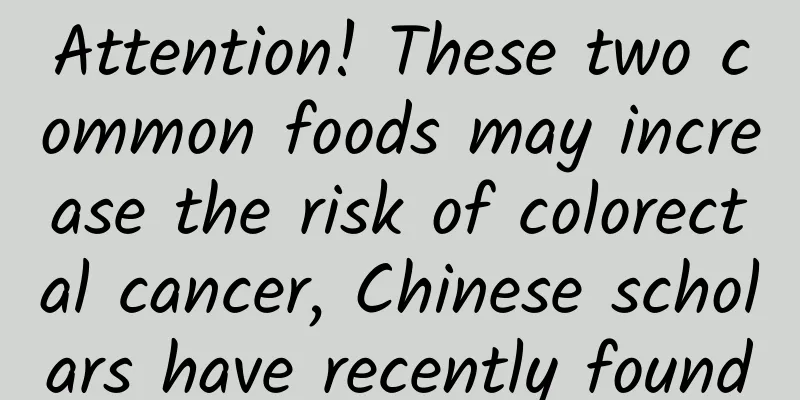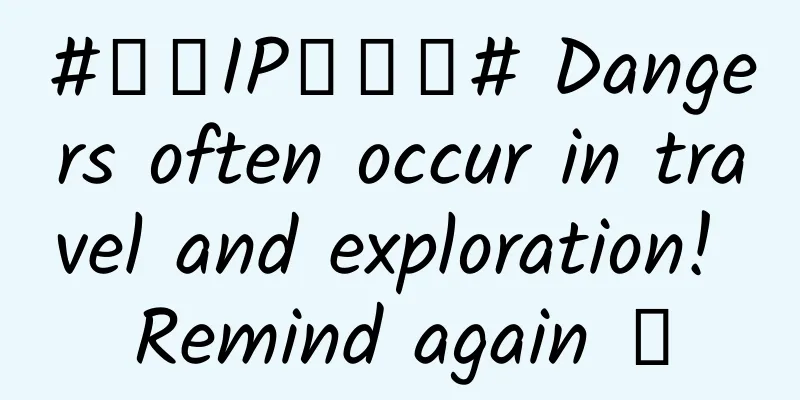Attention! These two common foods may increase the risk of colorectal cancer, Chinese scholars have recently found

|
The 2020 China Cancer Statistics Report shows that the incidence and mortality of colorectal cancer in my country rank second and fifth respectively among all malignant tumors. It is expected that the mortality rate of colorectal cancer will rise to second place by 2030. According to the American Cancer Society, colorectal cancer ranks third among the most common malignant tumors among adults in the United States. Sedentary lifestyle, obesity, smoking, excessive alcohol consumption, high intake of processed meats, and low intake of fruits and vegetables are considered lifestyle factors that increase the risk of colorectal cancer, while nutrition and food are considered important modifiable factors in the development of colorectal cancer . The incidence of colorectal cancer can be significantly reduced by implementing primary prevention strategies such as lifestyle changes, proper diet, avoidance of risk factors, and early detection through screening. Recently, researchers from Zhejiang University School of Medicine in China published a study titled "Diet-Wide Association, Genetic Susceptibility and Colorectal Cancer Risk: A Prospective Cohort Study" in the journal Nutrition, evaluating the relationship between certain food exposures and colorectal cancer risk. Using data from the UK Biobank, researchers from Zhejiang University School of Medicine analyzed data from 118,210 patients to study the risk of colorectal cancer associated with the intake of 139 foods and nutrients. They followed up the participants for nearly 12.8 years and found 1,466 cases of cancer (842 of which were colon cancer and 359 were rectal cancer) during the follow-up, with an average age of 55.87 years. Among the 139 foods and nutrients, 8 were associated with the risk of colorectal cancer (P < 0.05) (Figure 1). The results showed that higher alcohol intake (HR = 1.08 per SD increase in daily intake; 95% CI 1.03-1.14; P = 0.028) and white bread intake (HR = 1.10 per SD increase in daily intake; 95% CI 1.05-1.16; P = 0.003) were associated with an increased risk of colorectal cancer . In contrast , increased intake of dietary fiber, calcium, magnesium, phosphorus, manganese, and carbohydrates was associated with a lower risk of colorectal cancer , with HRs of 0.87, 0.89, 0.86, 0.85, 0.88, and 0.87 per SD increase in daily intake, respectively. Compared with the general population, people who are male, older, have a lower level of education, have a higher poverty index, have a family history of cancer, have a higher body mass index, are less physically active, smoke more, and have diabetes have a higher risk of colorectal cancer. Figure 1 The relationship between 139 dietary factors and the risk of colorectal cancer The study confirmed the previously reported positive association between alcohol and colorectal cancer risk. Ethanol in any type of alcoholic beverage is a risk factor for colorectal cancer, and ethanol's metabolite acetaldehyde has been identified as a human carcinogen by international research agencies. After alcohol ingested into the body reaches colonocytes, it diffuses in the lumen and is metabolized to acetaldehyde by microbial alcohol dehydrogenase in the lumen, leading to mucosal damage and proliferation of regenerative cells. The pathogenic effects of alcohol can be partly attributed to DNA methylation through the regulation of COLCA1/COLCA2 gene expression. The results of the study also showed that high dietary intake of calcium, magnesium and phosphorus was associated with a lower risk of colorectal cancer , but it was difficult to distinguish their independent effects. At the same time, the results of the case-control study found that the manganese intake of patients with colorectal cancer was lower than that of the control group, but no significant negative correlation was found. Animal experiments showed that tumor growth and metastasis were significantly enhanced in manganese-deficient mice. The observations also suggest that dietary fiber is a protective factor for colorectal cancer , which is consistent with previous findings. Dietary fiber can accelerate intestinal motility, dilute carcinogens in the colon, and ferment fiber into short-chain fatty acids by intestinal bacteria. All these mechanisms indicate that dietary fiber intake can reduce the risk of malignant tumors and improve colon health. In addition, dietary fiber can also serve as a basic measure for the prevention and adjuvant treatment of colorectal cancer. Although there is a mechanistic link between fiber intake and colorectal cancer risk, epidemiological studies have shown different results between fiber from different food sources and colorectal cancer. In a meta-analysis of prospective observational studies, fruit, vegetable, and legume fiber were not associated with colorectal cancer, while cereal fiber was associated with a reduced risk of colorectal cancer . Whole grains are the main source of cereal fiber and are negatively correlated with colorectal cancer incidence and mortality. This study provides evidence and recommendations for dietary prevention of colorectal cancer. However, the study also has limitations. The analysis is limited to European populations. In order to ensure that these findings are applicable to different populations, more and larger cohort studies are needed in the future to explore more associations between dietary components and colorectal cancer risk. Drinking has become an important risk factor for cancer and colorectal cancer In August 2021, the world-renowned academic journal The Lancet Oncology published a paper entitled "Global Cancer Burden Caused by Alcohol Consumption in 2020: A Population-Based Study", which estimated that 741,300 of all new cancer cases worldwide in 2020 were attributed to drinking, of which 76.7% were in men. The study found that among approximately 740,000 cancer cases, moderate drinking (<20 g per day) caused 13.9% of cancer cases; high-risk drinking (20-60 g per day) caused 39.4% of cancer cases; and alcoholism (>60 g per day) caused 46.7% of cancer cases. In other words, as long as you drink, your risk of cancer will increase significantly. A large number of studies have shown that drinking is one of the most important known causes of human cancer after smoking, chronic infection and obesity, and is closely related to the occurrence of colorectal cancer. In recent years, more and more related studies have shown that intestinal flora imbalance and intestinal barrier damage caused by long-term and heavy drinking are internal environmental factors for the occurrence and development of colorectal cancer. It is recognized that chronic intestinal inflammation is associated with the occurrence of colorectal cancer. It is one of the internal environmental factors. Intestinal bacterial transfer and the production of various cancer-related inflammatory factors caused by intestinal barrier defects can increase the risk of colorectal cancer. Because colorectal dysfunction causes abnormal colorectal microenvironment homeostasis, intestinal epithelial cell damage may occur. Intestinal barrier damage allows separated microorganisms to invade the intestinal wall tissue and produce an inflammatory response, or long-term alcohol stimulation of the colorectal mucosa triggers colorectal polyps and adenomas. After 5 to 10 years, it develops from advanced adenomas to precancerous lesions and then to colorectal cancer. Therefore, controlling alcohol intake is urgent and is a direction that the government, society, families and individuals need to work together. |
Recommend
Will the parallel lines of sadness ever meet one day?
When it comes to parallel lines, everyone is fami...
Ten thousand words of practical knowledge | The secrets of UGC operation are all here
Today, let’s talk about UGC. UGC is not a tool pr...
After sitting on a plane for several hours, I stood up and suddenly died! What happened?
There was a case where a passenger suddenly died ...
The purest football and the most advanced enjoyment of FIFA 17 trial play review
FIFA and Pro Evolution Soccer, as the old series ...
Three questions about users: Who are the users? Where do users come from? What does the user want to do?
There are three ultimate questions in philosophy:...
One picture tells you: Which generation of Android system is stronger?
When Google released Android 1.5, it started nami...
5K screen 27-inch iMac foreign media review summary
The Retina 5K iMac has already reached many forei...
WeChat Moments Advertising | Sharing of promotion data and examples in the financial industry
As of today, two issues of the WeChat Moments adv...
This plant is called "steel in wood" and can be found in Hainan →
Polei, also known as Hainan Polei. It is also cal...
For the first time in the world, how difficult is it to "dig soil" on the back of the moon?
On May 3, 2024, the Chang'e-6 probe boarded t...
Are the shelterbelts in the “Three Norths” planted in vain? No, because the sandstorms are “cheating”
Basically every spring, people living in the nort...
How to find a “host to promote products” so as not to lose money?
In my opinion, all businesses in China can be rou...
Are all animals color blind? Their vision may be richer than yours!
Should I buy the same toy ball in red or green? W...
Babao's money lesson for women: 10 minutes a day, manage money well from earning to spending
Babao's money lesson for women: 10 minutes a ...
Be careful when eating at gatherings. How to save yourself if food gets stuck in your throat?
If you encounter food choking, don't try any ...







![[Smart Farmers] "Dry and hot winds" are coming! Do you know what it is?](/upload/images/67f22ca7c17b2.webp)

